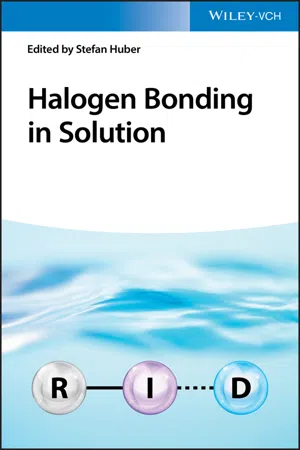
- English
- ePUB (mobile friendly)
- Available on iOS & Android
Halogen Bonding in Solution
About This Book
Long-awaited on the importance of halogen bonding in solution, demonstrating the specific advantages in various fields - from synthesis and catalysis to biochemistry and electrochemistry!
Halogen bonding (XB) describes the interaction between an electron donor and the electrophilic region of a halogen atom. Its applicability for molecular recognition processes long remained unappreciated and has mostly been studied in solid state until recently. As most physiological processes and chemical reactions take place in solution, investigations in solutions are of highest relevance for its use in organic synthesis and catalysis, pharmaceutical chemistry and drug design, electrochemistry, as well as material synthesis.
Halogen Bonding in Solution gives a concise overview of halogen bond interactions in solution. It discusses the history and electronic origin of halogen bonding and summarizes all relevant examples of its application in organocatalysis. It describes the use of molecular iodine in catalysis and industrial applications, as well as recent developments in anion transport and binding.
- Hot topic: Halogen bonding is an important interaction between molecules or within a molecule. The field has developed considerably in recent years, with numerous different approaches and applications having been published.
- Unique: There are several books on halogen bonding in solid state available, but this will be the first one focused on halogen bonding in solution.
- Multi-disciplinary: Summarizes the history and nature of halogen bonding in solution as well as applications in catalysis, anion recognition, biochemistry, and electrochemistry.
Aimed at facilitating exciting future developments in the field, Halogen Bonding in Solution is a valuable source of information for researchers and professionals working in the field of supramolecular chemistry, catalysis, biochemistry, drug design, and electrochemistry.
Frequently asked questions
Information
1
Halogen Bonding: An Introduction
1.1 Introduction
1.1.1 The Halogen Bond: Definition, Characteristics, Representations, and Parallels to the Hydrogen Bond
“A halogen bond occurs when there is evidence of a net attractive interaction between an electrophilic region associated with a halogen atom in a molecular entity and a nucleophilic region in another, or the same, molecular entity”IUPAC definition 2013 [2]
Table of contents
- Cover
- Table of Contents
- Title Page
- Copyright
- Preface
- 1 Halogen Bonding: An Introduction
- 2 Thermodynamics of Halogen Bonding in Solution
- 3 Recognition with Macrocycles and Interlocked Systems
- 4 The Three‐Center Halogen Bond
- 5 Spectroscopy of Halogen Bonding in Solution
- 6 Anion Transport in Lipid Bilayer Membranes Using Halogen Bonds
- 7 Catalysis by Molecular Iodine
- 8 Halogen Bonding in Organocatalysis
- 9 Halogen Bonding in Electrochemistry
- 10 Halogen Bonds in Biomolecular Engineering
- 11 The Chalcogen Bond in Solution: Synthesis, Catalysis and Molecular Recognition
- Index
- End User License Agreement